| The general process of setting up Backup to protect your important data is fairly easy, although there are a number of choices to be made during the process mostly revolving around where you want your backups to be made. You have three choices: Back up to iDisk This creates a backup on your iDisk over your Internet connection. Choose this option if you have a high-speed Internet connection, and be sure to limit the number of files you back up, or you'll overwhelm your iDisk. Back up to CD/DVD This creates a backup on recordable CDs or DVDs using your Mac's CD or DVD burner. Choose this option to create durable backups of your data, but remember you'll have to be by your Mac during the backup to provide it with blank discs. Back up to Drive This creates a backup on another hard drive or network volume. Choose this option to back up your important data to another hard drive or network volume.
When you fire up Backup for the first time, you'll be presented with its default setup. Although Backup can be set up to back up just about any files to just about any location on a schedule, it's not set up that way when you launch it. It's your job to customize these settings to suit your needs. Doing so is a three-step process: choosing where you want the files to be backed up, selecting which files are to be backed up, and setting up a schedule of when backups occur. Backup Strategy A good backup strategy involves making two or more backups, preferably stored in two or more locations. That way, if your main computer and one of your backups is destroyed, you'll have a second copy. Sure, it sounds redundant, but here's an example you've made a backup of your computer to DVD, and you've stored it in your basement. Then you have a house fire that starts in your basement and consumes not only your backup, but your computer, too. Do yourself a favor make two or more backups and put them in different physical locations, especially for important things such as financial data. |
To back up to iDisk 1. | In the Applications folder, double-click the Backup icon to launch the software.
Backup checks for an iDisk server as it launches. If this is the first time you've launched Backup, you may receive a message saying that BackupHelper wants permission to access your keychain (Figure 9.15). This is OK. If you've already launched Backup, go to Step 3.
Figure 9.15. If this is the first time you've launched Backup, you may be asked for access to your keychain. This is OK; click Always Allow. 
| 2. | Click Always Allow.
If this is the first time you've launched Backup, a dialog appears, thanking you for joining .Mac (Figure 9.16).
Figure 9.16. If this is the first time you've launched Backup, it thanks you for joining and provides some additional information. Click OK. 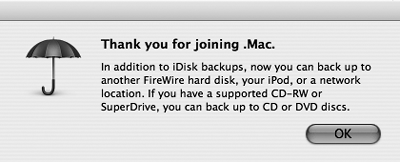
| 3. | Click OK.
Backup displays its main window (Figure 9.17).
Figure 9.17. The main Backup window is a pretty simple affair. It asks where files should be backed up; it provides a graphical representation of how much space is available on your iDisk; it lists the items to be backed up; it provides some information on scheduling and file size; and it has some basic controls, including a Backup Now button. 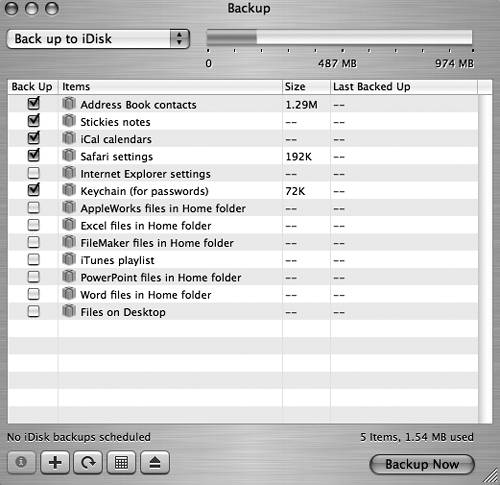
| 4. | From the pop-up menu in the upper left corner, choose Back up to iDisk (Figure 9.18).
Figure 9.18. The Backup pop-up menu offers three backup choices: Back up to iDisk, Back up to CD/DVD, and Back up to Drive. You need to choose one of them to create a backup. 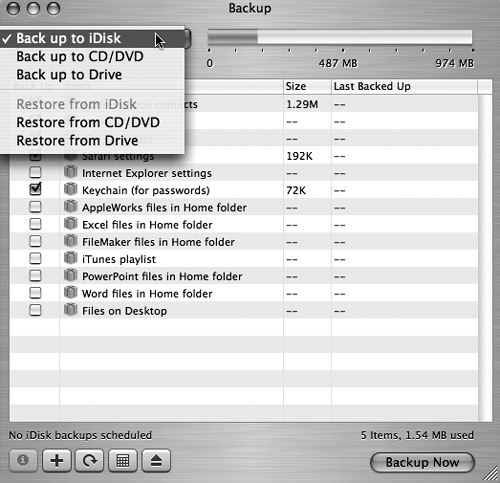
| 5. | In the Back Up column of the main window, check the boxes to the left of the items that you want to back up (Figure 9.19).
Figure 9.19. When you check the boxes to the left of the items you want to have backed up, Backup will scan your hard drive for those items and automatically include them. 
| 6. | At the top of the window, check the available-space gauge to ensure that you have enough space to copy the selected items. This gauge appears when you select Back up to iDisk in step 4 (Figure 9.20).
Figure 9.20. When backing up files to your iDisk, check the gauge at the top to ensure that you have enough space available for the files you've selected in the Back Up column. 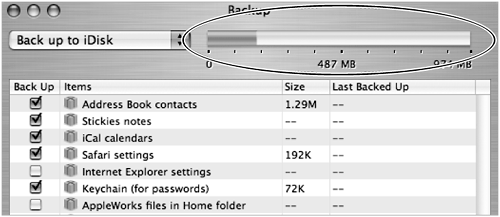
| 7. | In the lower right corner of the window, click the Backup Now button (Figure 9.21).
Figure 9.21. Click the Backup Now button to begin your backup. 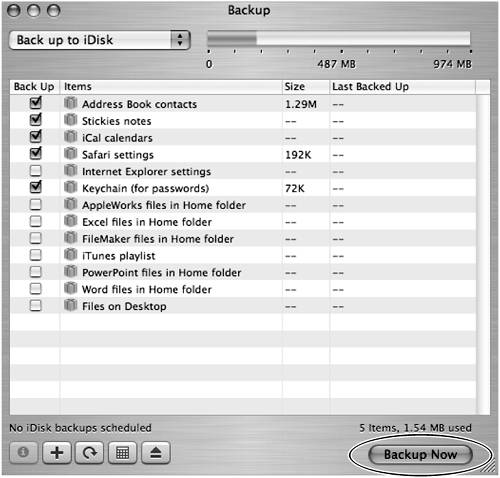
Backup scans for the files to be saved and goes straight to work creating your backup in the location you've specified. You'll see a progress bar as items are copied to the location you set in step 4.
|
 Tip Tip
When backing up files to your iDisk, you'll need to have your .Mac member name and password entered in the .Mac system preferences, and you'll have to have Internet access (which makes sense when you think about it). A backup can potentially take up gigabytes of space, so when backing up to your iDisk, remember that you'll need to make the backup small enough to fit on your iDisk.
To back up to a CD or DVD 1. | Open Backup.
If this is the first time you've launched Backup, you may receive a message saying that BackupHelper wants permission to access your keychain (see Figure 9.15). This is OK. If you've already launched Backup, go to step 3.
| 2. | Click Always Allow.
If this is the first time you've launched Backup, a dialog appears, thanking you for joining .Mac (see Figure 9.16).
| 3. | Click OK.
Backup displays its main window.
| 4. | From the pop-up menu in the upper left corner, choose Back up to CD/DVD (Figure 9.22).
Figure 9.22. Choose Back up to CD/DVD from the Backup pop-up menu to back up items to optical discs. 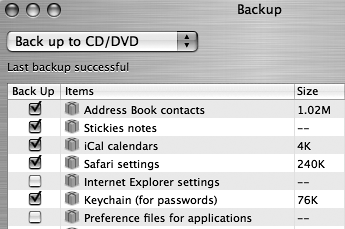
| 5. | In the Back Up column of the main window, check the boxes to the left of the items that you want to back up (Figure 9.23).
Figure 9.23. When you check the boxes to the left of the items you want to have backed up, Backup will scan your hard drive for those items and automatically include them. 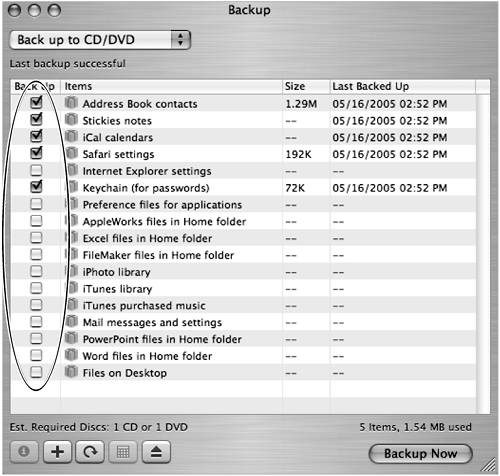
| 6. | In the lower right corner of the window, click the Backup Now button.
A dialog pops up, asking you to name your backup.
| 7. | In the "Name your backup" field, type a name for your backup, and then click Begin Backup (Figure 9.24).
Figure 9.24. Before backing up to CD/DVD media, Backup requires you to name your backup. It provides a good one, though the current date and time. If you like this name, or after you've typed in a name of your own, click Begin Backup. 
Backup asks you to insert a disc (Figure 9.25).
Figure 9.25. To continue the backup process, insert a CD and click Burn when the button becomes activated. 
| 8. | Insert a disc.
The Burn button is activated.
| 9. | Click Burn (Figure 9.26).
Figure 9.26. Click the Burn button to burn the backup to CD or DVD. 
Backup burns the files to the disc that you inserted (Figure 9.27). Depending on the size of the backup, you may need to insert more than one disc when asked. When finished with the process, Backup provides a short summary dialog, giving you the name that you should use to label the CD or DVD, and noting how many discs the backup used (Figure 9.28).
Figure 9.27. After you click the Burn button, Backup goes to work gathering files and burning them to CD or DVD. 
Figure 9.28. When finished, Backup tells you whether the backup process was successful, what to label the disc, and how many discs the process used. 
| 10. | Click OK to finish.
|
 Tips Tips
When you back up your data to CDs or DVDs, Backup tells you in advance how many blank disks you'll need to do the job. Backup allows backing up to CDs and DVDs only if your Mac has a Mac OS X supported optical drive there's a complete list at Mac OS X Storage Device Support (www.apple.com/macosx/upgrade/storage.html).
To back up to a drive 1. | Open Backup.
If this is the first time you've launched Backup, you may receive a message saying that BackupHelper wants permission to access your keychain (see Figure 9.15). This is OK. If you've already launched Backup, go to step 3.
| 2. | Click Always Allow.
If this is the first time you've launched Backup, a dialog appears, thanking you for joining .Mac (see Figure 9.16).
| 3. | Click OK.
Backup displays its main window.
| 4. | From the pop-up menu in the upper left corner, choose Back up to Drive (Figure 9.29).
Figure 9.29. Select Back up to Drive from the Backup pop-up menu to back up items to hard drives or network volumes. 
| 5. | At the top of the window, click the Set button (Figure 9.30).
Figure 9.30. Click the Set button to set a location on a drive for your backup. 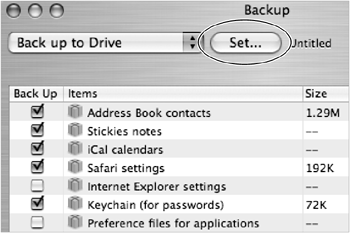
| 6. | In the "Set a backup location" sheet that drops down, click Create (Figure 9.31).
Figure 9.31. Click Create to create a new backup file and set a location in which backups will take place. 
| 7. | In the file browser window that rolls down, navigate to the location you want to use for the backup, type a name for your backup in the Save As field, and click Create (Figure 9.32).
Figure 9.32. In the file browser, navigate to the location you want to use for your backup, give it a name in the Save As field, and click Create. We're calling this backup "Weekly" to indicate how often we'll use it for a backup, but you can name it practically anything. 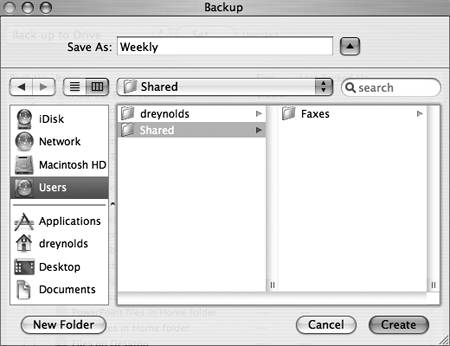
Backup displays its main window with the new location represented in the top portion of the window, just to the right of the Set button (Figure 9.33).
Figure 9.33. The main Backup window has your new backup listed at the top. Here, it's named Weekly, but it could be named anything even "Spike MacRashton." 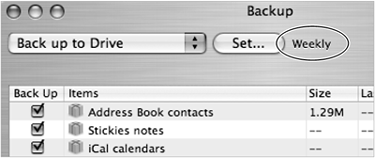
| 8. | In the Back Up column, check the boxes of the items that you want to back up (Figure 9.34).
Figure 9.34. When you check the boxes to the left of the items you want to have backed up, Backup will scan your hard drive for those items and automatically include them. 
| 9. | In the lower right corner of the window, click the Backup Now button (Figure 9.35).
Figure 9.35. Click the Backup Now button to begin your backup. 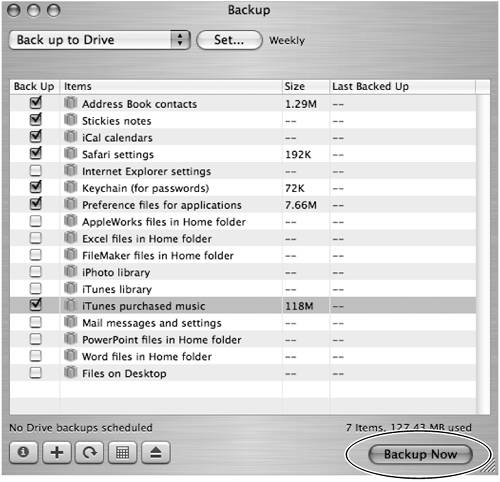
Backup scans for the files to be saved and goes straight to work creating your backup in the location you've specified. You'll see a progress bar as items are copied to the location you set in Step 4.
|
 Tip Tip
|







 Tip
Tip












